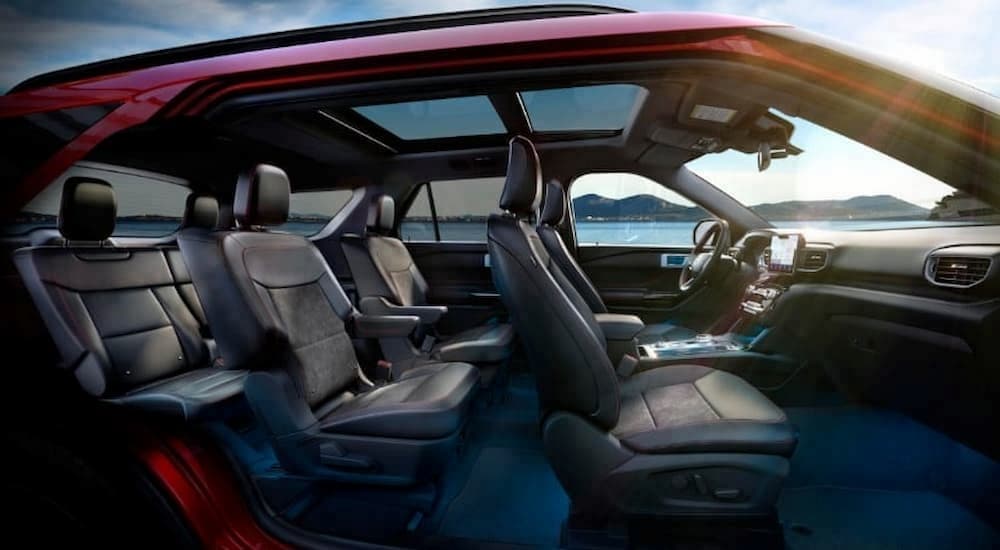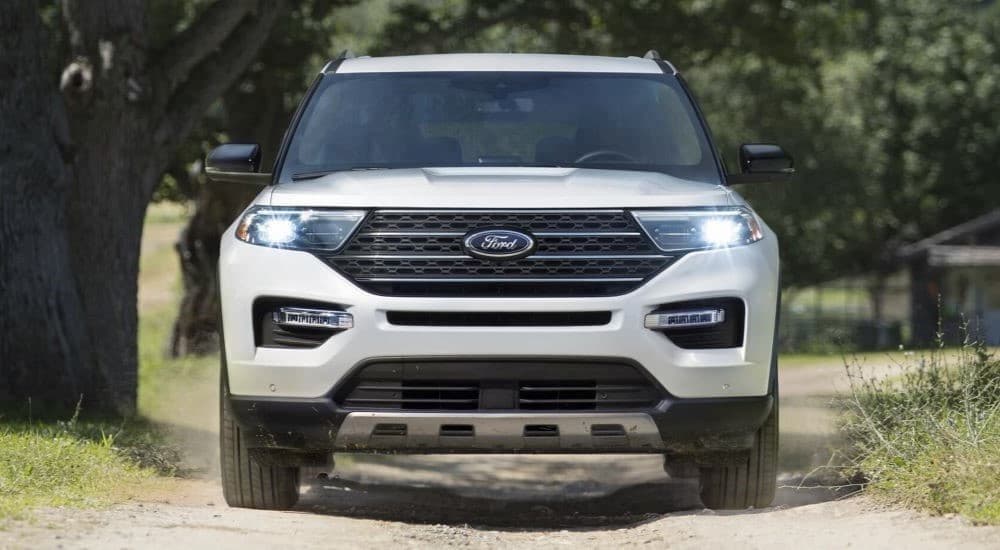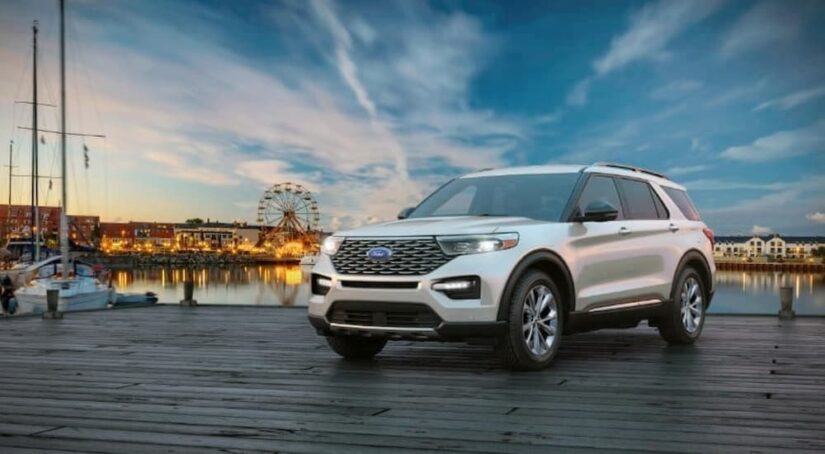There are plenty of aspects to consider when buying a new SUV; from exterior design to fuel economy to towing capacity, it can be overwhelming to look at everything at once. One element that can really make a difference when it comes to your day-to-day driving experience is a vehicle’s interior. Many people choose SUVs over sedans because they want more interior space, and things like cargo management systems and the layout of tech features can make the difference between a smooth and relaxing experience and a frustrating time in the captain’s chair.
Today we’re going to take a look at the interior of the 2023 Ford Explorer, a midsize SUV that’s available in a range of different trim levels. When you see a Ford Explorer for sale, you’ll want to check out its powertrain options (including a traditional gas-powered version and an efficient hybrid), its exterior style options, and its available packages, including a trailer/tow package that allows it to pull up to 5,600 lbs. But amid all of that, don’t forget to pay attention to what’s inside the cabin—after all, that’s where you’ll be spending the bulk of your time.
Let’s explore this SUV’s interior further. There are plenty of standard features that keep passengers comfortable and give you direct access to relevant drive data and convenience tools. You can also opt for a higher trim level or an optional package to get additional features that provide a deeper sense of extravagance or amenity.

Seating Options
The Explorer can seat up to seven people comfortably, making it a good choice for people with big families or those who like to go on road trips with friends. On the other hand, if you don’t need to take a full three rows of people along for the ride, then you can fold down the back seats to expand the rear cargo area. You can fold the seats flat on any trim of the Explorer: lower trim levels have seats that can be folded manually, while higher ones are equipped with PowerFold seats that can be tucked away at the push of a button.
The seats themselves can also vary based on the trim level and package you choose. On the base model, the Explorer offers an eight-way power-adjustable driver seat as a standard feature, but the front passenger will have to settle for a four-way manual-adjustable seat. Upgrade to XLT, and you’ll get a ten-way power driver seat and four-way power front passenger seat. The ST-Line trim and above boast a standard eight-way power passenger seat alongside the ten-way power driver seat.
But there’s still more comfort to be had by climbing the trim ladder since the ST, King Ranch, and Platinum feature multi-contour seats with Active Motion as an available option in the front row. Designed with long drives in mind, these seats have massage functions built in to prevent sore muscles and fatigue. There are five upper and lower back massage themes, helping drivers find a mode that’s right for them.
Heating & Cooling
Plenty of features on the Explorer allow you to cool down during hot summer days and stay warm during the winter. These options vary quite a bit from trim to trim, so let’s break it down…
The base trim has tri-zone automatic climate control with rear auxiliary vents that lets everyone choose their ideal temperature. Rear auxiliary controls are an available option. In addition to the climate control system, the XLT trim has first-row heated seats, and a heated steering wheel is an available option; the ST-Line trim has these, too, but makes the heated steering wheel standard. The ST trim makes heated second-row seats an available option. The Limited, King Ranch, and Platinum trims add ventilation to the first-row seats, and the second-row seats are heated as a standard feature.

Tech Layout
All versions of the 2023 Explorer come standard with Ford’s SYNC 3 software, which features Apple CarPlay and Android Auto compatibility so you can connect your phone to the SUV’s infotainment interface. But what exactly does that interface entail? On every trim level, a large touchscreen displays information and allows you to change various settings. The basic version is an 8.0-inch touchscreen, and the top-tier option is a vertically-oriented 10.1-inch screen that’s both brightly lit and easy to customize.
Using the touchscreen is easy when you’re parked and getting your navigation directions set up, and the front passenger can use it throughout the drive, but it’s not always the best way to make adjustments while you’re driving. Fortunately, the Explorer has plenty of more tactile controls; there are physical buttons and knobs for adjusting the climate control, audio volume, and more.
In addition to the controls in the middle of the dashboard, there are also buttons built into the steering wheel that let you take calls, set up cruise control, and control your audio entertainment without getting distracted.
Behind the wheel, you’ll find the instrument panel cluster. The base trim features a 4.2-inch color LCD productivity screen in this area; XLT, ST-Line, Timberline, and Limited trims have a 6.5-inch screen, while ST, King Ranch, and Platinum have a large 12.3-inch screen. These screens put important information right in the driver’s line of sight, so they don’t have to take their eyes off the road for too long. The larger the digital area, the more customizable the instrument panel is so that drivers can prioritize the most important information.
All trims of the Explorer feature a USB-A port and a USB-C port up front that can be used to connect devices to the infotainment setup and recharge them while en route. Higher trim levels add smart-charging USB ports in the second row so that more passengers can keep their phones connected to the power source at the same time. A wireless charging pad for compatible smartphones is also available on some trims, letting you leave your cords behind.

Cargo Management
Even if you don’t fold down any seats, the cargo area in the back has plenty of space for groceries, luggage, or camping equipment. Cargo hooks come standard across all trim levels, so you can keep shopping bags in place and use more vertical space without stacking too many things on top of each other. If you want to get even more organized, you can opt for the available cargo management system, which provides extra pockets on the side and a covered space under the floor.
Interior Lighting
The amount and type of light in the cabin can play a big role in setting the mood. If you want to let in some extra sunlight during a nice day, consider an Explorer with a twin-panel moonroof. You can cover it up when you prefer shade, just let the light in, or open it up fully to get a refreshing breeze. If you like to go camping, you can also use the moonroof to stargaze from the comfort of your vehicle.
Of course, lighting is most important at night, when the sun isn’t there to help you out. All trims of the Explorer come with dome lights in all three rows, so all passengers can take a look at maps or travel guides if they’re going off the grid or aren’t getting a signal on their GPS—or read books in their downtime. In addition to these utilitarian lights, upper trim levels like the King Ranch and Platinum feature multi-color ambient lighting in the first two rows. You can switch between seven different colors, making it easy to match the lighting to your mood.
Some Final Thoughts
Clearly, the Explorer’s interior can change quite a bit depending on which trim level you choose. The base trim unfolds a spacious and comfortable cabin, but the extra creature comforts and convenience tech on the Platinum can go a long way toward improving your drive, especially on a cross-country road trip.
At the end of the day, it all depends on your priorities and your budget. With so many different variations available, it shouldn’t be too hard to strike a balance that works for you.



